‘A world of silence can still be full of music,’ says deaf artiste Lily Goh
This article was first published in The Sunday Times on Nov 2, 2025 as part of The Straits Times Signature Series

ON the twenty-second floor of the CapitaSky building, overlooking the southern shores of Singapore’s coastline, deaf arts and music artiste Lily Goh enraptures an audience in sign language during a workshop.
Her fingers move non-stop as she communicates, her expressive eyes do a lot of the talking, her enthusiasm remains infectious throughout the 90-minute workshop, with simultaneous interpretation of her sign language, getting her message across easily to those in the room, with 20 of the 25 people being employees of Equinix, a company that provides global digital infrastructure services.
It is Sept 23, the day when the International Day of Sign Languages is observed around the world to raise awareness of the importance of sign language for the deaf community.
Ms Goh dives into the different ways in which deafness is interpreted, a brief history of the Singapore Sign Language (SgSL), the finger-and-hand symbols for various alphabets and ways in which they are combined into words and sentences.
Towards the end, she initiates a game to test the skills gained.
It leaves the room filled with laughter, smiles and handshakes – with some getting it right and others still trying to get it right.
For Ms Goh, this means a great deal. It’s awareness that she’s trying to raise to make Singapore inclusive for deaf people and enable many more conversations between them and the hearing world.
“My purpose is simple: To make Singapore inclusive for deaf people,” she says in a conversation with The Sunday Times.
“It is to close the communication gap. And to encourage everyone to embrace our deaf community as a cultural-linguistic group.”
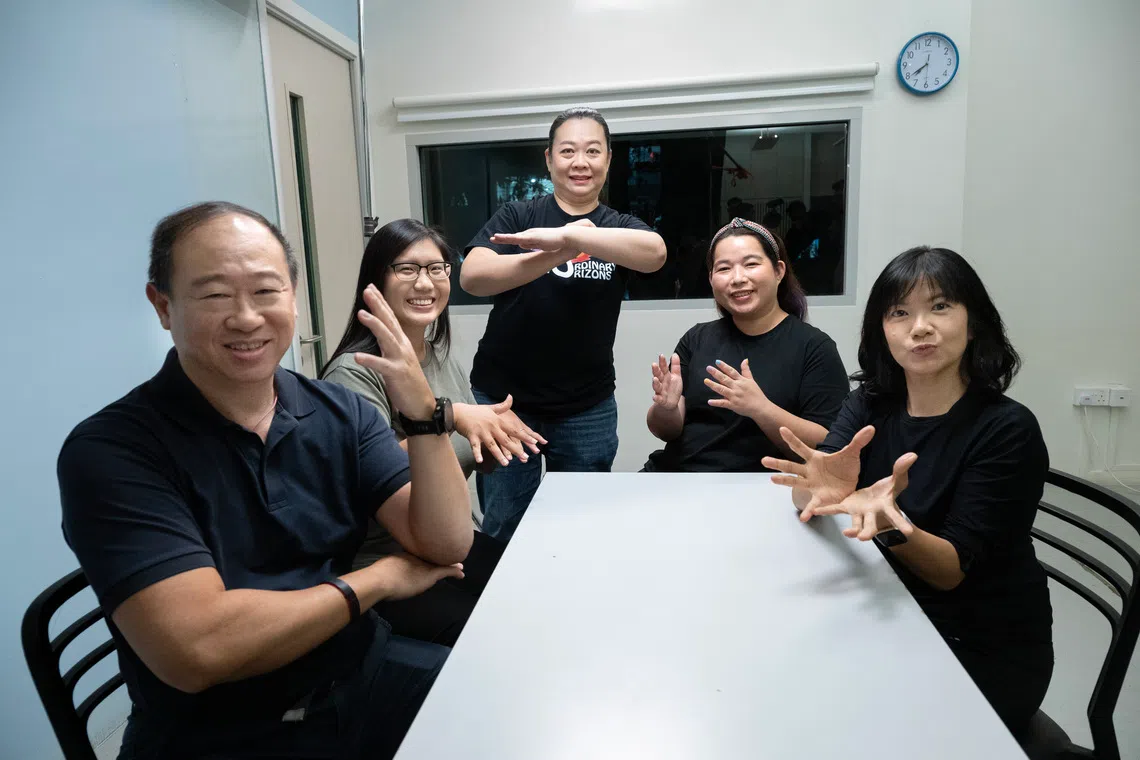
Different roles, common focus
Versatile and multifaceted, Ms Goh plays several roles within her community.
As an artiste, entrepreneur and advocate, she has been a role model showing the way for members of her community to not let hearing disability get in the way of leading accomplished, fulfilling lives.
For many others, she fills their world of silence with music by coming up with her own way of letting them experience music with her visual interpretation.
This champion of deaf people founded ExtraOrdinary Horizons (EO Horizons) in 2011 as a social enterprise focused on teaching SgSL to individuals and corporates, and raising public awareness.
“I saw too many barriers. Deaf people are being left out of conversations. Shut out of the arts,” she says.
“I started EO Horizons because I knew how it felt to be excluded. I wanted to create a space I never had, where deaf people could see themselves on stage, and the hearing world could see us too.”
Many of her days as an artiste and entrepreneur are busy, filled with training sessions, talks and performances to make communication easier and draw attention to issues that would make life better for members of her community.
Over the years, Ms Goh has impacted the lives of hundreds and thousands with her work – both in person and virtually. She regularly teaches SgSL during her TikTok livestream sessions and uses it to perform deaf music for her followers.
Process designer Jimmy Chan, 54, who works in the gas and oil industry and is hard of hearing, and his wife Della Chu, 47, a teacher, are among those who have benefited from her work.
“Knowing Lily has introduced me to a different and engaging way to communicate with my two lovely daughters. They’ve also picked up sign language,” he says.
Inspired by Ms Goh’s entrepreneurial spirit, Mr Chan hopes to join her as a facilitator or trainer one day, or pursue his desire to start an inclusive gym/fitness workout programme.
“She’s amazing,” says Ms Chu, her voice filled with gratitude. “She has truly opened the doors for the deaf community, fostering greater understanding that deaf people can also appreciate music concerts and performances like everyone else.”
EO Horizons, on its website, mentions that it has impacted the lives of 58,270-plus people through deaf awareness efforts, and close to 1,500 students have completed various levels of SgSL communication courses.
But the numbers don’t matter that much to Ms Goh. “When people walk up to me and share how my efforts have helped improve their lives, it means a lot to me,” she says.
While a lot of progress has been made in Singapore to improve the lives of those with hearing difficulties over the years, there is “still much to do”, she notes.
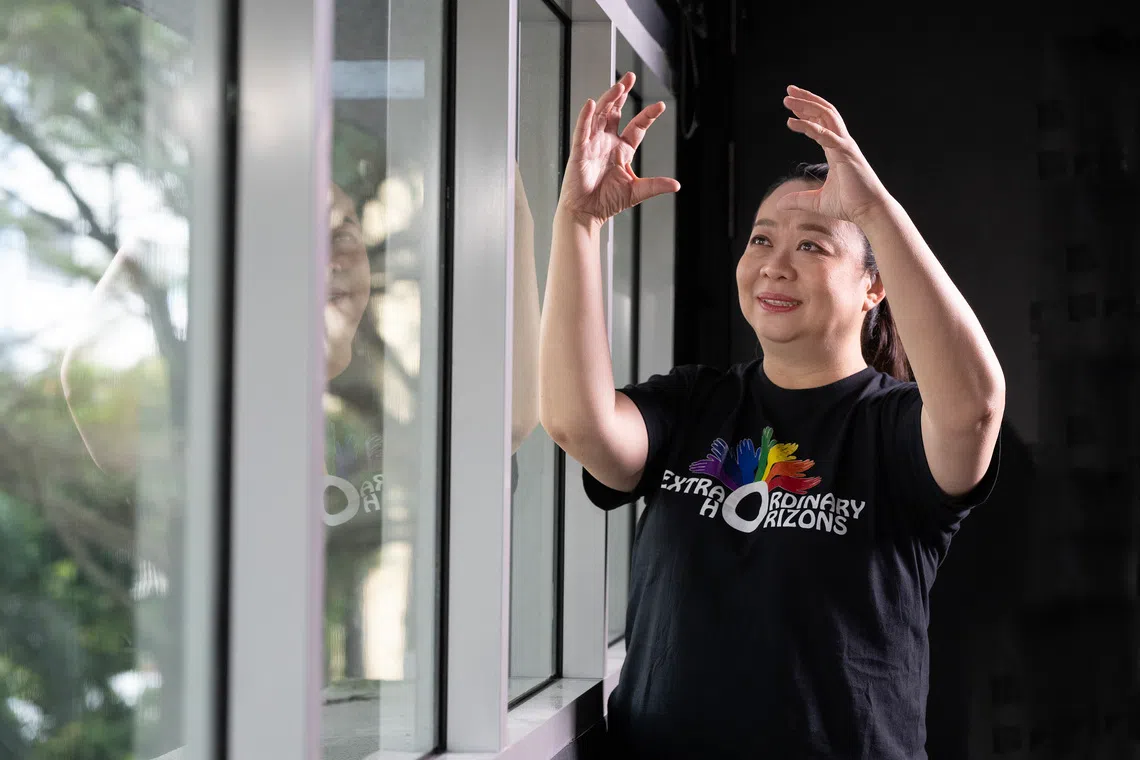
Ms Evaline Woon, 27, a teacher who describes herself as a friend and a student of Ms Goh, says the artiste is an inspiration, adding that Ms Goh’s work has encouraged her to tell her students who have sight and hearing issues to have the courage to chase their dreams.
“Lily shows that you can have success in any field. I tell my students they don’t have to fit into what society wants, and can break out of the narrative that academics are the only way forward,” she tells ST.
For Ms Goh’s mentee and SgSL teaching assistant, Ms Tay Wei Ling, 47, working with her and learning from her has helped to develop her “sense of belonging in the deaf community”.
“In the past, I used to feel very lost, but now that I can use SgSL far more easily, I feel at home in the deaf community,” she says.
Another friend who is also deaf and has known Ms Goh since the late 1990s, has tracked art developments in Singapore for the deaf community. The woman, who declined to be named, says Ms Goh is not the first artiste who’s striving to improve the conditions for deaf people.
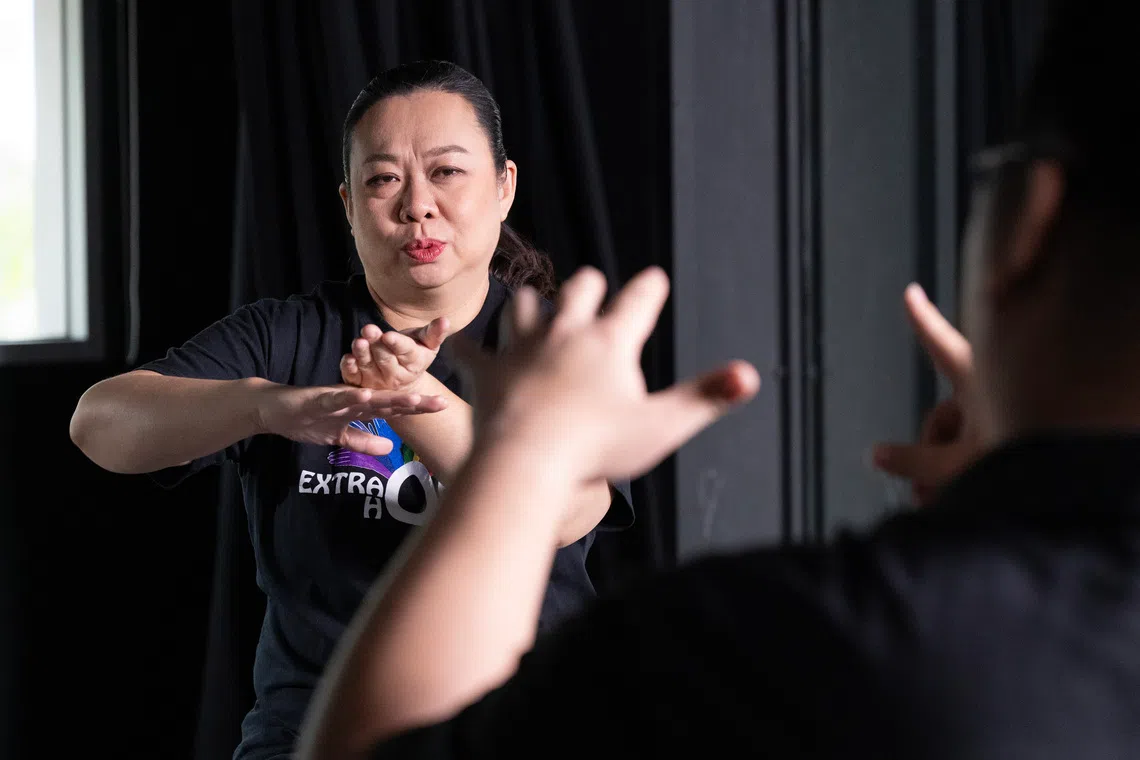
There have been others before her – including at least one prominent artist who moved overseas because of the opportunities in the West, she says.
“There is a lot more work to be done in the deaf community here,” she tells ST.
As an example, she cites a law passed in the United Kingdom that requires all music concerts be made accessible to people with disabilities.
“Since the rule took effect, you’ll find that British pop stars will ensure that facilities allow deaf people to enjoy their concerts even when they perform overseas,” she says.
But she noted that Singapore does not have a similar law, which means that it would be difficult for those hard of hearing to attend all concerts.
“Artistes like Lily Goh need a lot of encouragement. They have to juggle so many things, including raising sponsorship, finding interpreters and so much more,” she says.
“We need many more artistes like her and hearing allies to collaborate to meet the needs of the deaf community, especially in the arts scene.”
A world of music
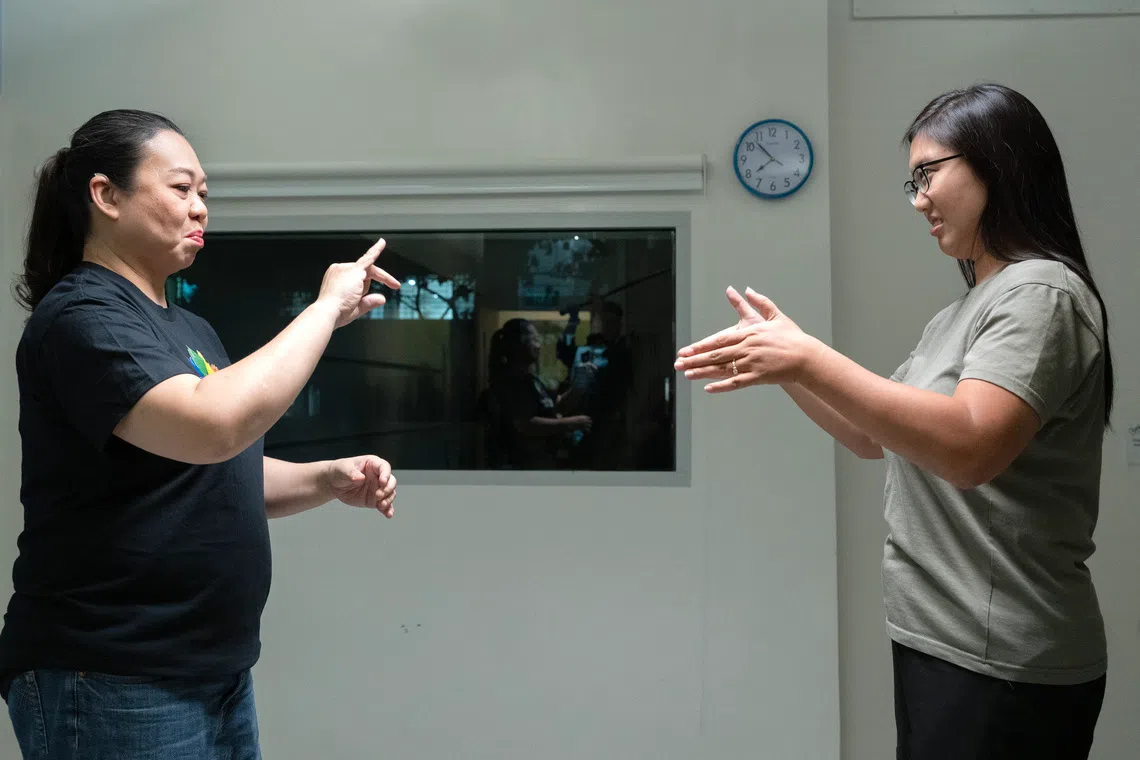
Ms Goh was born with hearing abilities, but at the tender age of two, she started to have hearing issues and became the only one in her family who is deaf.
Her two brothers tried various ways of communicating with her, but often in school and elsewhere she felt “isolated”. She didn’t have many friends because of the communication issue.
In primary school, where everyone signed, she felt “free being among other deaf people”. “I felt empowered,” she tells ST.
In secondary school, however, where both hearing and deaf girls were accepted, signing was not allowed and she felt excluded.
“There were no interpreters provided for us. So we struggled a lot. I felt alone. Those moments left a mark that I’ll never forget,” she says.
One day, a fine arts teacher at her secondary school selected her to play the percussion in a concert band.
Ms Goh was introduced to the world of music and, through vibration and touch, she discovered rhythm. “I learnt that music could live in me. This changed everything,” she recalls.
Her teachers told her they hoped she would one day become like the world-famous Scottish percussionist Evelyn Glennie, who was diagnosed as deaf at the age of 12 but still went on to become the first person in history to create and sustain a full-time career as a solo percussionist and has performed with orchestras worldwide.
“Could I become like her? I asked myself,” says Ms Goh. “Could I provide that leadership in the deaf community? Could we play together? Some of my deaf friends have no exposure or experience,” she adds, recalling the many questions that popped up in her head.
She decided to try, and it exposed her to all the problems that deaf people face.
“Many don’t have the support, the money or even know where to start. They don’t have a space where they can express themselves freely,” she says.
“So I did what I could in this space: to play, to perform, to create a world where deaf people can express themselves freely.”
While watching music shows and performances, she realised the sign language interpreters were simply telling the audience what was happening on stage. “I was confused. I was like you’re telling me they’re playing the violin. Hmmm, I didn’t feel connected to the music,” she recalls.
This was a barrier she decided to try to amend, and she feels particularly good when she can interpret the music visually for her audience in a way that allows them to “experience” the music.
To enable this, a lot goes on beforehand. She spends time trying to understand the tones and intricacies of the music, learn about the composers, the meanings they are trying to convey and how it could be artistically interpreted for deaf people.
Explaining how she performs, Ms Goh says: “On the actual day of the concert, the hearing interpreter relays the timing to me and I also use my hearing aids to listen to the music itself, and it all helps me come up with my own artistic expression of the music.
“When deaf and hard-of-hearing people sit in the audience and watch me, I hope they get a full, complete understanding of the lyrics as well as experience the magic of the music they are listening to.
“It’s my way of showing them that a world of silence can still be full of music.”
Ms Woon, the teacher who can hear, says: “I hate orchestra music. But when Lily is interpreting it, I feel quite immersed in the music.”
The road ahead
One of the things that irks Ms Goh is how hearing people often think of deaf people as having a disability and can’t do things themselves. “I’m fed up with that. We have a lot of work to do to explain and change people’s mindsets that we can’t do things,” she tells ST.
“We deaf people don’t need help. We can lead independent lives. We don’t want to be seen as objects of pity. We are the same as everyone else. We can socialise, we can work like everyone else. We just want the opportunities to be able to do so.”
Ms Goh, who made it through two rounds of the national talent contest Singapore Idol in 2004, winning hearts with her rendition of Eternal Flame by The Bangles, says emphatically that her first language is SgSL and she wants it to gain widespread recognition.
This interview for the ST Signature Series was conducted with the help of an interpreter. While she is fluent in English and can read lips, Ms Goh says it is her way of spreading awareness and bridging the communication gap.
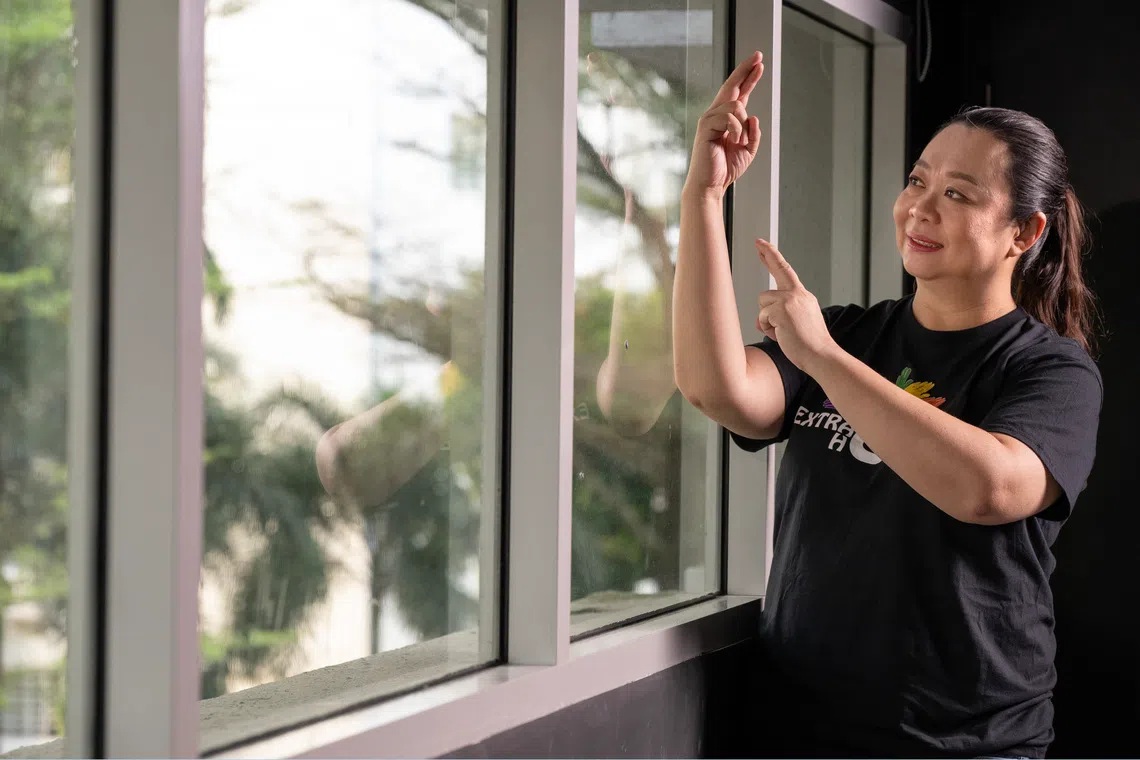
Her to-do list has quite a few items.
She’s studying the impact that artificial intelligence can or will have on their community. She wants to train more people in visual storytelling so many more can enjoy music shows. She wants to research music for the deaf in different genres. And, sometime in the future, she wants to start a music training programme for deaf people.
But her priority now is to grow the pool of SgSL interpreters and instructors who can train more hearing and deaf people to learn the skills to understand the desires, wishes, thoughts and more of the hard of hearing and converse with them.
This, she says, will go a long way in allowing the deaf community to feel included in every space they wish to be a part of.
“I really want to teach sign language to as many hearing people as possible, so there will be more deaf interpreters in Singapore,” she says.
“I have seen my students become interpreters. Some of them start volunteering with deaf people, and as their number grows, it will start to close that communication gap for deaf people in society. It will allow them to feel more equal in Singapore.
“Singapore should be a place where deaf people can better enjoy the arts, culture and other aspects of society equally, just as everybody else.”

Elevated insights from seasoned perspectives. Crafted by journalists. Powered by Purpose: The Straits Times Signature Series is a new editorial project helmed by experienced journalists to shine a light on people, themes and ideas that rarely get the attention they deserve in everyday news cycles.
Shefali Rekhi is a senior editor & writer working on special projects. She joined The Straits Times in 2000 and has helmed two Asia-focused projects, efforts to grow the paper’s international reach and fight fake news. She writes on a range of issues.
Decoding Asia newsletter: your guide to navigating Asia in a new global order. Sign up here to get Decoding Asia newsletter. Delivered to your inbox. Free.
Copyright SPH Media. All rights reserved.


